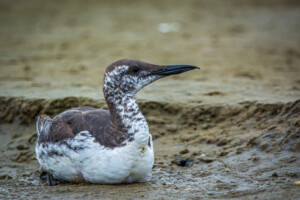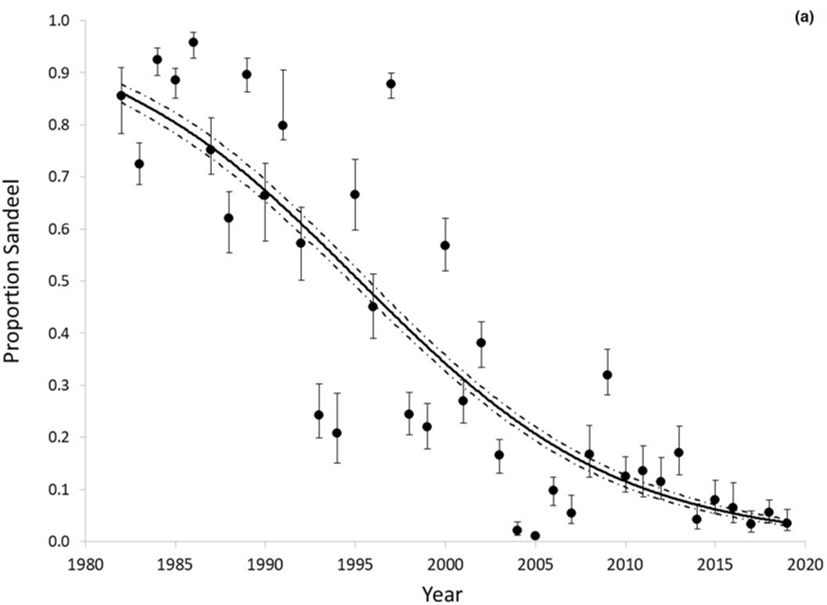
LINKED PAPER
Long‐term within‐season changes in the diet of Common Guillemot (Uria aalge) chicks at a North Sea colony: implications for dietary monitoring. Harris, M. P., Albon, S. D., Newell, M. A., Gunn, C., Daunt, F., & Wanless, S. 2022. IBIS. DOI: 10.1111/ibi.13063. VIEW
Seabirds serve as vital indicators of the marine environment’s state (Cook et al. 2014). By closely monitoring the dietary habits of specific species, valuable insights into the health of prey communities can be gained (Anderson et al. 2014). In a recent study, Michael Harris and his colleagues compiled a long-term dataset (running from 1982 to 2019) of chick provisioning by Common Guillemots (Uria aalge). Their analyses revealed a drastic change in diet, highlighting the importance of comprehensive sampling across the entire breeding season.
Sandeel and Sprat
The data were collected on the Isle of May National Nature Reserve in southeast Scotland. Between 1982 and 2019, ornithologists diligently kept track of the fish species that Common Guillemots brought to their chicks. These observations showed that Lesser Sandeels (Ammodytes marinus) were the main prey species in the early years (1980s and 1990s). Yet, the prevalence of Lesser Sandeels in the diet waned over time, as they were increasingly replaced by Sprat (Sprattus sprattus). Furthermore, the delivery of Lesser Sandeels shifted toward the initial stages of the breeding season.

Figure 1. The proportion of Lesser Sandeel in the diet of Common Guillemot chicks has decreased over the years.
Phenological mismatch
These patterns imply that the peak availability of Lesser Sandeels has progressively advanced earlier in the year. This change created a discrepancy between prey availability and the breeding season of Common Guillemots, leading to a so-called phenological mismatch (Visser & Gienapp 2019). Fortunately, the Common Guillemots managed to adapt by transitioning to a different prey source, namely the Sprat. Without the long-term dataset and meticulous sampling approach spanning the entire breeding period, this dietary shift could have been overlooked. Selecting sampling points either too early or too late in the year would have yielded a biased picture of the Common Guillemot’s diet. Thus, accounting for within-season dietary variations proves pivotal in the study of seabirds (Barrett et al. 2007).
References
Anderson, H.B., Evans, P.G.H., Potts, J.M., Harris, M.P. & Wanless, S. (2014). The diet of Common Guillemot Uria aalge chicks provides evidence of changing prey communities in the North Sea. Ibis 156: 23–34. VIEW
Barrett, R.T., Camphuysen, K. (C. J.), Anker-Nilssen, T., Chardine, J.W., Furness, R.W., Garthe, S., Hüppop, O., Leopold, M.F., Montevecchi, W.A. & Veit, R.R. (2007). Diet studies of seabirds: a review and recommendations. ICES Journal of Marine Science 64: 1675–1691. VIEW
Cook, A.S.C.P., Dadam, D., Mitchell, I., Ross-Smith, V.H. & Robinson, R.A. (2014). Indicators of seabird reproductive performance demonstrate the impact of commercial fisheries on seabird populations in the North Sea. Ecological Indicators 38: 1–11. VIEW
Visser, M. E., & Gienapp, P. (2019). Evolutionary and demographic consequences of phenological mismatches. Nature Ecology & Evolution 3: 879-885. VIEW
Image credits
Top right: SCommon Guillemots (Uria aalge) | Stephan Sprinz | CC BY-SA 4.0 Wikimedia Commons
Blog posts express the views of the individual author(s) and not those of the BOU.
If you want to write about your research in #theBOUblog, then please see here




